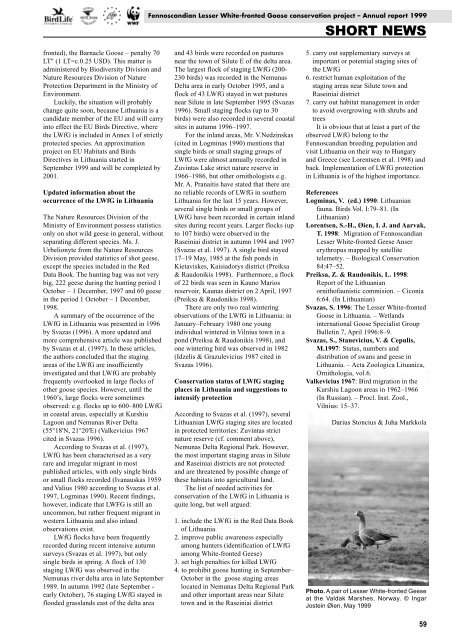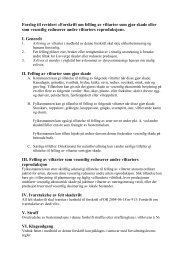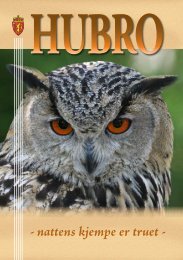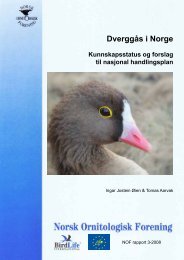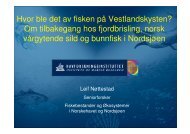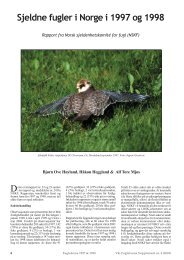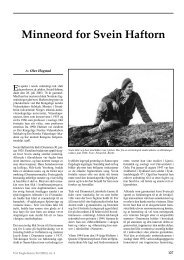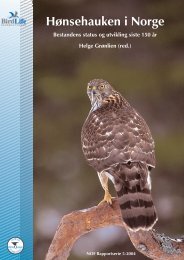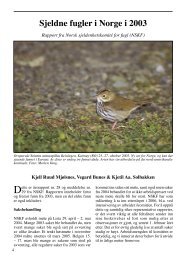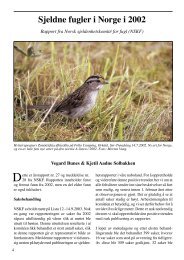Fennoscandian Lesser White-fronted Goose conservation project ...
Fennoscandian Lesser White-fronted Goose conservation project ...
Fennoscandian Lesser White-fronted Goose conservation project ...
You also want an ePaper? Increase the reach of your titles
YUMPU automatically turns print PDFs into web optimized ePapers that Google loves.
<strong>fronted</strong>), the Barnacle <strong>Goose</strong> – penalty 70<br />
LT" (1 LT=c.0.25 USD). This matter is<br />
administered by Biodiversity Division and<br />
Nature Resources Division of Nature<br />
Protection Department in the Ministry of<br />
Environment.<br />
Luckily, the situation will probably<br />
change quite soon, because Lithuania is a<br />
candidate member of the EU and will carry<br />
into effect the EU Birds Directive, where<br />
the LWfG is included in Annex I of strictly<br />
protected species. An approximation<br />
<strong>project</strong> on EU Habitats and Birds<br />
Directives in Lithuania started in<br />
September 1999 and will be completed by<br />
2001.<br />
Updated information about the<br />
occurrence of the LWfG in Lithuania<br />
The Nature Resources Division of the<br />
Ministry of Environment possess statistics<br />
only on shot wild geese in general, without<br />
separating different species. Ms. J.<br />
Urbelionyte from the Nature Resources<br />
Division provided statistics of shot geese,<br />
except the species included in the Red<br />
Data Book. The hunting bag was not very<br />
big, 222 geese during the hunting period 1<br />
October – 1 December, 1997 and 60 geese<br />
in the period 1 October – 1 December,<br />
1998.<br />
A summary of the occurrence of the<br />
LWfG in Lithuania was presented in 1996<br />
by Svazas (1996). A more updated and<br />
more comprehensive article was published<br />
by Svazas et al. (1997). In these articles,<br />
the authors concluded that the staging<br />
areas of the LWfG are insufficiently<br />
investigated and that LWfG are probably<br />
frequently overlooked in large flocks of<br />
other goose species. However, until the<br />
1960’s, large flocks were sometimes<br />
observed: e.g. flocks up to 600–800 LWfG<br />
in coastal areas, especially at Kurshiu<br />
Lagoon and Nemunas River Delta<br />
(55°18'N, 21°20'E) (Valkevicius 1967<br />
cited in Svazas 1996).<br />
According to Svazas et al. (1997),<br />
LWfG has been characterised as a very<br />
rare and irregular migrant in most<br />
published articles, with only single birds<br />
or small flocks recorded (Ivanauskas 1959<br />
and Valius 1980 according to Svazas et al.<br />
1997, Logminas 1990). Recent findings,<br />
however, indicate that LWFG is still an<br />
uncommon, but rather frequent migrant in<br />
western Lithuania and also inland<br />
observations exist.<br />
LWfG flocks have been frequently<br />
recorded during recent intensive autumn<br />
surveys (Svazas et al. 1997), but only<br />
single birds in spring. A flock of 130<br />
staging LWfG was observed in the<br />
Nemunas river delta area in late September<br />
1989. In autumn 1992 (late September -<br />
early October), 76 staging LWfG stayed in<br />
flooded grasslands east of the delta area<br />
<strong>Fennoscandian</strong> <strong>Lesser</strong> <strong>White</strong>-<strong>fronted</strong> <strong>Goose</strong> <strong>conservation</strong> <strong>project</strong> – Annual report 1999<br />
and 43 birds were recorded on pastures<br />
near the town of Silute E of the delta area.<br />
The largest flock of staging LWfG (200-<br />
230 birds) was recorded in the Nemunas<br />
Delta area in early October 1995, and a<br />
flock of 43 LWfG stayed in wet pastures<br />
near Silute in late September 1995 (Svazas<br />
1996). Small staging flocks (up to 30<br />
birds) were also recorded in several coastal<br />
sites in autumn 1996–1997.<br />
For the inland areas, Mr. V.Nedzinskas<br />
(cited in Logminas 1990) mentions that<br />
single birds or small staging groups of<br />
LWfG were almost annually recorded in<br />
Zuvintas Lake strict nature reserve in<br />
1966–1986, but other ornithologists e.g.<br />
Mr. A. Pranaitis have stated that there are<br />
no reliable records of LWfG in southern<br />
Lithuania for the last 15 years. However,<br />
several single birds or small groups of<br />
LWfG have been recorded in certain inland<br />
sites during recent years. Larger flocks (up<br />
to 107 birds) were observed in the<br />
Raseiniai district in autumn 1994 and 1997<br />
(Svazas et al. 1997). A single bird stayed<br />
17–19 May, 1985 at the fish ponds in<br />
Kietaviskes, Kaisiadorys district (Preiksa<br />
& Raudonikis 1998). Furthermore, a flock<br />
of 22 birds was seen in Kauno Marios<br />
reservoir, Kaunas district on 2 April, 1997<br />
(Preiksa & Raudonikis 1998).<br />
There are only two real wintering<br />
observations of the LWfG in Lithuania: in<br />
January–February 1980 one young<br />
individual wintered in Vilnius town in a<br />
pond (Preiksa & Raudonikis 1998), and<br />
one wintering bird was observed in 1982<br />
(Idzelis & Grazulevicius 1987 cited in<br />
Svazas 1996).<br />
Conservation status of LWfG staging<br />
places in Lithuania and suggestions to<br />
intensify protection<br />
According to Svazas et al. (1997), several<br />
Lithuanian LWfG staging sites are located<br />
in protected territories: Zuvintas strict<br />
nature reserve (cf. comment above),<br />
Nemunas Delta Regional Park. However,<br />
the most important staging areas in Silute<br />
and Raseiniai districts are not protected<br />
and are threatened by possible change of<br />
these habitats into agricultural land.<br />
The list of needed activities for<br />
<strong>conservation</strong> of the LWfG in Lithuania is<br />
quite long, but well argued:<br />
1. include the LWfG in the Red Data Book<br />
of Lithuania<br />
2. improve public awareness especially<br />
among hunters (identification of LWfG<br />
among <strong>White</strong>-<strong>fronted</strong> Geese)<br />
3. set high penalties for killed LWfG<br />
4. to prohibit goose hunting in September–<br />
October in the goose staging areas<br />
located in Nemunas Delta Regional Park<br />
and other important areas near Silute<br />
town and in the Raseiniai district<br />
SHORT NEWS<br />
5. carry out supplementary surveys at<br />
important or potential staging sites of<br />
the LWfG<br />
6. restrict human exploitation of the<br />
staging areas near Silute town and<br />
Raseiniai district<br />
7. carry out habitat management in order<br />
to avoid overgrowing with shrubs and<br />
trees<br />
It is obvious that at least a part of the<br />
observed LWfG belong to the<br />
<strong>Fennoscandian</strong> breeding population and<br />
visit Lithuania on their way to Hungary<br />
and Greece (see Lorentsen et al. 1998) and<br />
back. Implementation of LWfG protection<br />
in Lithuania is of the highest importance.<br />
References<br />
Logminas, V. (ed.) 1990: Lithuanian<br />
fauna. Birds Vol. I:79–81. (In<br />
Lithuanian)<br />
Lorentsen, S.-H., Øien, I. J. and Aarvak,<br />
T. 1998: Migration of <strong>Fennoscandian</strong><br />
<strong>Lesser</strong> <strong>White</strong>-<strong>fronted</strong> Geese Anser<br />
erythropus mapped by satellite<br />
telemetry. – Biological Conservation<br />
84:47–52.<br />
Preiksa, Z. & Raudonikis, L. 1998:<br />
Report of the Lithuanian<br />
ornithofaunistic commision. – Ciconia<br />
6:64. (In Lithuanian)<br />
Svazas, S. 1996: The <strong>Lesser</strong> <strong>White</strong>-<strong>fronted</strong><br />
<strong>Goose</strong> in Lithuania. – Wetlands<br />
international <strong>Goose</strong> Specialist Group<br />
Bulletin 7, April 1996:8–9.<br />
Svazas, S., Stanevicius, V. & Cepulis,<br />
M.1997: Status, numbers and<br />
distribution of swans and geese in<br />
Lithuania. – Acta Zoologica Lituanica,<br />
Ornithologia, vol.6.<br />
Valkevicius 1967: Bird migration in the<br />
Kurshiu Lagoon areas in 1962–1966<br />
(In Russian). – Procl. Inst. Zool.,<br />
Vilnius: 15–37.<br />
Darius Stoncius & Juha Markkola<br />
Photo. A pair of <strong>Lesser</strong> <strong>White</strong>-<strong>fronted</strong> Geese<br />
at the Valdak Marshes, Norway. © Ingar<br />
Jostein Øien, May 1999<br />
59


